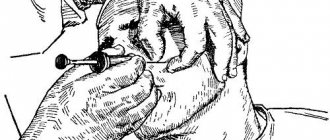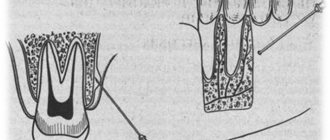Anesthesia plays a huge role in modern medicine. After all, thanks to it, doctors have the opportunity to perform operations and a number of special examinations that are accompanied by pain.
Modern anesthesia involves rather complex pain relief techniques. Therefore, for these purposes there is a certain doctor, who is called an anesthesiologist.
Spinal anesthesia
The largest percentage of pain relief occurs under general anesthesia, that is, anesthesia. However, it is also possible to perform local anesthesia. This type of loss of sensitivity involves anesthesia of only certain areas of the human body.
However, in certain situations and individual indications, another type of anesthesia is often performed, the name of which is “spinal anesthesia.”
What is spinal anesthesia?
This anesthesia technique represents a regional loss of sensation in the patient. In this case, there is a complete temporary “switching off” of any sensations in the area of the body located below the navel. This type of anesthesia is an excellent replacement for general anesthesia. The process of injecting a patient with spinal anesthesia is carried out by injecting a certain drug into the back, which turns off the nerves responsible for pain.
During spinal anesthesia, the patient “turns off” sensitivity in the area below the navel
The advantages of this method of pain relief are:
- minimal blood loss during the operation;
- the risk of postoperative blood clots and pulmonary thromboembolism is significantly reduced;
- reducing negative effects on the lungs and heart;
- no nausea or weakness;
- absence of pain in the postoperative period;
- the possibility of direct contact with the doctor during surgery;
- the opportunity to eat well after surgery.
Types of infiltration anesthesia
Conventionally, two types of infiltration anesthesia can be distinguished: direct and indirect. With direct anesthesia, the drug is injected directly into the surgical area. This type of anesthesia is used during soft tissue operations.
With the indirect (diffuse) type of infiltration anesthesia, the anesthetic is administered at some distance from the area that needs to be anesthetized. By diffusion, the solution reaches the tissues in the intervention area. For example, introducing an anesthetic solution around the surgical field when opening an abscess or injection under the periosteum when numbing a tooth. The effect of the drug is determined not only by the pharmacokinetic properties, concentration and amount of solution, but also by the condition of the infiltrated tissues (local inflammation, scar-adhesive process reduce the analgesic effect).
Technology of anesthesia
To ensure complete painlessness, anesthesia is administered into the cavity of the spinal column, located between the membranes of the brain and spinal cord. This area is filled with cerebrospinal fluid - cerebrospinal fluid. Thanks to the anesthetic entering this space, a complete “switching off” of the lower body is achieved. This result is achieved by blocking nerve impulses emanating from the nerve roots of the spine to the brain. Therefore, a person does not feel anything during the action of the drug.
An analgesic agent is injected into the subarachnoid space
Administering spinal anesthesia requires specialist technical skill as the process is not easy. In addition, spinal anesthesia is performed using medical instruments that reduce the risk of complications after anesthesia.
Such tools include:
- alcohol disinfecting cotton swabs for antiseptic procedures;
- two syringes, one of which contains a local anesthetic for a less sensitive spinal puncture. And the second syringe is filled directly with an analgesic agent for spinal anesthesia;
- a special needle for performing a spinal puncture. By the way, it is much thinner than the one used for epidural anesthesia.
Technique of infiltration anesthesia
The method of infiltration anesthesia was developed at the end of the 19th century, but the anesthetics used at that time were highly toxic.
The technique became more widespread after the introduction of novocaine into practice. This agent could be administered in larger volumes without significant risk of toxicity. The disadvantages of infiltration anesthesia at that time were: delayed development of anesthesia, the need for additional tissue infiltration during surgery, and the risk of toxic effects of the anesthetic. A.V. managed to eliminate these shortcomings. Vishnevsky, who proposed the technique of tight “creeping infiltration”. The method is still widely used in small operations. Features of the technique include the use of a weak solution of novocaine (0.25%) and infiltration of a large volume of anesthetic into fascial closed spaces. The anesthetic solution is injected into the tissue under increased pressure and spreads over a considerable distance within the fascial sheath, while the drug acts on the axons of neurons innervating the intervention area. High hydrostatic pressure promotes closer contact of novocaine with nerve endings. This leads to a rapid development of anesthesia and allows the surgeon to immediately begin the operation. In addition, thanks to the “creeping infiltration” method, hydraulic tissue preparation is ensured, facilitating such surgical procedures as the separation of adhesions, tumor isolation, and others.
The process of spinal anesthesia
After completing all the above doctor’s instructions, you can proceed directly to the anesthetic injection. To do this, the patient must provide the doctor with good access to the spine, taking a position lying on his side, or sitting, with his back bent as much as possible.
This is followed by treatment of the anesthesia injection area with antiseptic drugs and an injection of local anesthetic from the first syringe. Then the anesthesiologist administers the anesthetic, based on the rules for the technique of administering this anesthesia - specifically into the subarachnoid space.
The required dosage of the drug is calculated by the anesthesiologist in advance. It is determined based on an analysis of the individual characteristics of the human body: height, weight, age.
It is worth noting that the puncture site is usually located between the II and III vertebrae of the lumbar spinal column, but it is also acceptable to administer an anesthetic up to the V vertebra. The choice of location for spinal anesthesia depends on the individual structure of the spine, the presence of previous injuries or surgical interventions.
Spinal anesthesia is most often administered between the second and third or third and fourth lumbar vertebrae
Options for using infiltration anesthesia
The technique of local anesthesia has its own characteristics depending on the type of operation and area of intervention. Currently, the classic version of infiltration anesthesia according to A.V. Vishnevsky is rarely used, but its elements continue to be used during various operations, including abdominal interventions.
One type of infiltration anesthesia is case blockade . It may be required for injuries or operations on the extremities. It is performed using a 0.25% solution of novocaine, trimecaine or lidocaine by introducing flexors or extensors into the sheaths. To do this, the skin and muscles are anesthetized, and then using a thin needle they reach the bone and, retreating a few millimeters, inject a certain amount of anesthetic. The drug is usually administered from two points. For closed fractures of the tubular bones of the extremities, the anesthetic can be injected directly into the hematoma.
Several types of infiltration anesthesia are used in dentistry: intramucosal, submucosal, spongy anesthesia, intrapulpal, intraligamentary, infiltration anesthesia of soft tissues, anesthesia under the periosteum.
Feel
After direct administration of the drug, a person gradually begins to feel heaviness in the legs or a slight tingling sensation. This indicates that the administered drug is beginning to work. After a few minutes, sensitivity completely disappears. Before surgery, the doctor must test for loss of sensitivity. If suddenly a person feels an unpleasant sensation, more like an electric shock, you should immediately tell a doctor about it.
In some situations, longer spinal anesthesia may be required. In this case, a special instrument, a catheter, is placed in place of the previous puncture for additional administration of the medicine.
Anesthetics for anesthesia
For spinal anesthesia, agents with various properties are used. Each of these drugs gives a different effect in terms of duration of exposure. Patients with allergic diseases should not worry: there are a lot of options for administered medications, and the doctor will definitely replace a drug that is unsuitable for the individual body with one with a similar effect. Here are some of the medications that are used for spinal anesthesia: Narolin, Novocaine, Mezaton, Fraxiparine, Lidocaine, Bupivacaine and many others.
"Mezaton"
For your information, the table below shows the active ingredients used in spinal anesthesia drugs, their dosages and the duration of action of each of them. Thanks to this table, the patient can determine whether he is allergic to a particular drug and whether the dosage is appropriate for him.
| Medicine | Concentration of solutions, (%) | Maximum dose, (mg) | Duration of action (minutes) |
| Procaine hydrochloride | 0.25 or 0.5 | 500 | 40-60 |
| Lidocaine | 2-5 (hyperbaric solution) | 15-100 | 60-90 |
| Tetracaine hydrochloride | 0.5 (hypobaric, isobaric or hyperbaric solution) | 5-20 | from 180 (hyperbaric solution) to 270 (hypobaric solution) |
| Bupivacaine hydrochloride | 0.5 (isobaric or hyperbaric solution | 10-20 | 90-150 |
| Artikain | 5 (hyperbaric solution) | 100-150 | up to 120 |
Advantages of the method
- The rapid onset of the effect of loss of sensitivity and blocking of nerve impulses.
- It is successfully used during caesarean section or to ease contractions during childbirth. Thanks to the safe effect on the patient’s body, the mother in labor does not have to worry about the health of the baby.
- A much smaller dose of the drug enters the patient’s body compared to other types of anesthesia.
- By using a thin needle when injecting the drug, the risk of internal damage is minimized.
- This anesthesia technique involves the muscles being as relaxed as possible, which greatly helps the surgeon during the operation.
- There is minimal intoxication of the body when the drug is administered, since the percentage of the anesthetic entering the blood is in isolated cases.
- The analgesic effect does not affect the respiratory system; therefore, problems associated with the lungs are automatically excluded, as is the case with general anesthesia.
- The patient remains conscious, which helps to immediately eliminate complications, since direct contact is maintained between doctors and the patient during the entire surgical process.
- Minimal risk of complications after puncture due to the simplicity of the anesthetic injection technique.
Spinal anesthesia has many advantages
Local anesthesia
Local anesthesia in a general sense is the anesthesia of a separate field in which surgical procedures are performed, while maintaining the patient's consciousness.
Local anesthesia allows you to numb the specific area where the intervention is planned. At the time of the manipulation, the patient is fully conscious, absolutely adequately assesses what is happening around him and has the ability to quickly respond to a changing situation and sensations. In fact, the use of local anesthesia in most cases is more than justified and is sufficient for even complex surgical operations.
For local administration of all types of anesthetics, special reusable syringes are used, which have a recess for inserting a carpule - this is a hermetically sealed ampoule with an anesthetic.
Painless administration of the drug using so-called carpule syringes is ensured by a very thin needle, which allows the drug to be administered slowly without damaging the tissue. All reusable syringes, like other reusable instruments, must undergo basic antiseptic treatment in disinfection solutions, sterilization using modern ultrasonic equipment and autoclaving (temperature treatment under pressure).
A carpule (or cartridge) is a transparent glass cylindrical container with a silicone piston at one end and a silicone stopper and metal cap at the other end. The design guarantees safety.
Types of local anesthesia
Application anesthesia
Application is widely used during simple operations with a short-term analgesic effect. For application (superficial, terminal) anesthesia, excellent penetrating and permeating the upper layers of the skin or oral mucosa are used, blocking receptors and peripheral nerve fibers, which provides an analgesic effect.
The drug in the form of a solution, gel, ointment, aerosol of high concentration is applied with a sterile cotton swab or fingers to the treated area, penetrates the soft tissue layer, reducing their sensitivity. The drug penetrates to a depth of 3 mm. Very often, this type of anesthesia precedes another type of anesthesia.
The effect is achieved in just a few minutes and lasts up to 25 minutes.
Infiltration anesthesia
Infiltration anesthesia consists of an injection that is injected around. In everyday life, this type of anesthesia is often called “freezing”.
This is the most commonly used method of pain relief, used to work on soft tissues in maxillofacial surgery, during operations on the alveolar process, during tooth extraction and treatment. Infiltration anesthesia can be performed with the introduction of an anesthetic sub- and inside the mucous membrane, supraperiosteally, into the periodontal fissure, as well as when administered intraosseously.
As a rule, the doctor decides on its use when treating the teeth of the upper jaw, since the alveolar process has a more porous structure, which provides a more effective result.
The action time is about 1 hour, enough to carry out manipulations above the average level of complexity - endodontic treatment, pulp removal, treatment of complex (deep) caries.
Conduction anesthesia
The purpose of general anesthesia during dental procedures is to block the nerve that transmits the pain signal. As a result of this, the effect of “disabling” an entire row or section of the jaw is achieved, and not just the diseased tooth.
This type is most often used when it is necessary to treat or remove several teeth located nearby at once (use on the lower jaw is most common).
Action time is from 1.5 to 2 hours. A widely used option is called conduction mandibular anesthesia. As mentioned earlier, this type makes it possible to effectively anesthetize the lower jaw and perform complex interventions in the area of molars.
Anesthesia for intraligamentous administration
Intraligmentary is also called intraperiodontal dental anesthesia. A special feature of this type is the application of greater pressure during the administration of the drug. Penetration into the intraosseous space is ensured by uniform distribution of the product in the periodontal space.
It begins to act almost instantly - after 15-45 seconds. Action time is from 20 minutes to half an hour.
Intraosseous anesthesia
The decision to use this type is made by the doctor in the case when, due to specific factors, the use of other types of anesthesia is impossible or ineffective.
Typically used in the treatment and removal of chewing teeth of the lower jaw (molars), operations on the alveolar process. Creating a hole in the bone tissue with the help of a bur in this case involves dissecting the mucous membrane, the needle enters the resulting hole, and anesthesia is applied to the spongy substance under noticeable pressure. The drug is effective even at relatively small doses, which can be considered an advantage when choosing this type of anesthetic.
Action time – from 1 hour.
Trunk anesthesia
This type involves influencing the branches of the trigeminal nerve at the very base of the skull. The use of this type is justified when the doctor plans versatile surgical manipulations in the maxillofacial apparatus while the anesthetic has an analgesic effect simultaneously on the upper and lower jaws.
The dentist will correctly select an effective and safe anesthetic drug, taking into account the planned treatment and the possible psycho-emotional stress of the patient.
Benefits of local anesthesia
- almost absolute blocking of any unpleasant sensations,
- safety, modern products do not have a toxic effect on your body,
- rapid excretion through the kidneys,
- unlike general anesthesia, they have virtually no side effects,
- the drug is selected based on the clinical picture, health conditions and age of the patient.
A logical question: are there any disadvantages to local anesthesia?
Local anesthesia is highly effective and shows virtually no disadvantages when used. Unlike drugs that were used previously, modern anesthetics are absolutely safe, have a minimum of contraindications, are easily eliminated from the body, do not harm the cardiovascular system, and do not have a destructive effect on the kidneys and liver. With professional administration, the patient will not feel any pain even during long surgical procedures.
Anesthesia safety is an extremely important aspect of treatment!
The constant increase in the range of drugs increases the level of responsibility of the administration of our center and doctors for a professionally oriented and pharmacologically sound choice of effective and safe anesthetic drugs, especially for patients at anesthetic risk.
In our dental center, the entire range of medicinal products undergoes strict control and is taken into account in the latest national system of digital product labeling “Honest Sign”.
Negative consequences of spinal anesthesia
In order for the patient to decide to undergo spinal anesthesia, he needs to familiarize himself in advance with information about the disadvantages of this method of pain relief.
- During the medication administration process, the patient's blood pressure may drop sharply. Therefore, hypotensive patients are given drugs that increase blood pressure in advance - of course, if necessary. For hypertensive patients, this consequence can only have a positive effect.
- The time of loss of sensitivity is directly related to the dose of the drug. If sensitivity returns before the required time, and there is not enough time to complete the operation, the patient is immediately placed under general anesthesia. The spinal anesthesia method does not involve constant support of the anesthetic in the body; most often it is administered once. However, do not worry, since modern medicine uses medications that last up to six hours, which in most cases allows the surgeon to carry out all the manipulations on time.
- Headaches are a frequent companion of the patient after recovery from anesthesia.
Infiltration anesthesia in dentistry
The operating principle of infiltration anesthesia is to stop the nerve impulse that is transmitted from the pulp to the brain. It is manifested by numbness of the treated area: sensitivity is restored as the components of the drug are broken down in cellular tissues. The effect is achieved almost instantly and covers only a certain area, and the drugs used are safe for the human body, since the concentration of active substances in them is minimal.
In order to eliminate the risk of an allergic reaction to the anesthetic in the patient, the dentist conducts preliminary testing. Having individually selected the drug, he determines its dose and injects it into the tissues by injection, following a certain technique. Distributed throughout the cells, the anesthetic stops nervous activity and eliminates pain during dental procedures. It can be entered:
- Under the skin;
- Under the oral mucosa;
- Into the tissue surrounding the bone (periosteum).
Depending on the method of administration, infiltration anesthesia is:
- Direct – targeted introduction into the area that will be subjected to dental procedures;
- Indirect - injection of the entire area adjacent to the pathological focus with penetration of the active components deep into the tissue.
Indications for using spinal anesthesia technique
- Surgery of the legs or perineum.
- Reducing the risk of thrombosis in older people during leg surgery.
- Due to the impossibility of administering general anesthesia for lung diseases, both acute and chronic stages.
- Pinched sciatic nerve.
- Radicular syndrome.
- The need to reduce the tone of intestinal muscle tissue during operations on the gastrointestinal tract.
- The need to relax the walls of blood vessels in people with heart problems, with the exception of hypertensive patients and patients with heart valve problems.
There are many indications for the use of spinal anesthesia.
Local anesthesia in dentistry: types and preparations
In therapeutic and surgical dentistry, various types and techniques of pain relief are used. These include conduction, intracanal, intraligamentous, etc. They differ in the place of application of the anesthetic and the characteristics of administration, as well as the duration of the effect.
In modern dental clinics, carpule anesthesia is used: the anesthetic is supplied in disposable carpules - cartridges in which painkillers are mixed in the required proportions. They are inserted into syringes with screw-on disposable needles. This makes it possible to ensure sterility, since the doctor does not need to open the containers - contact of the drug with air is excluded.
Conductor
Conduction anesthesia is designed to temporarily block the nerve that transmits the pain signal. This makes it possible to numb several teeth at once, since the sensitivity of a certain area of the jaw is lost. This type of anesthesia is used in cases where it is necessary to remove or treat 2-3 teeth located nearby. It is also used for operations on soft tissues. This anesthesia lasts for at least one and a half hours.
Application anesthesia
Application anesthesia is a type of non-injection anesthesia. Apply the product with your finger or a cotton swab to the selected area. Absorbing into soft tissues to a depth of 3 mm, the medicine can reduce their sensitivity for a short period of time. Most often, this method is used to make the injection painless.
There is another form of drug release - in the form of an aerosol. However, such drugs are used less frequently because there is a possibility of inhalation and the components entering the bloodstream.
Infiltration
There are two types: direct (introduction of the drug under the mucous membrane near the teeth), indirect (introduction into the surrounding tissues). In the first case, the effect is more local, in the second, a larger area is anesthetized.
Infiltration anesthesia is often used for the teeth of the upper jaw. The alveolar processes have a less dense structure, so anesthesia is effective within one hour. In most cases, this is quite enough to perform many procedures, such as treating deep caries, filling root canals, etc.
Intraligamentary
It is also called intraligamentous. This anesthesia differs in that when administering the drug, the doctor applies more pressure so that the drug can be distributed in the periodontal tissues and penetrate into the intraosseous space. This type of pain relief begins to work in less than a minute. However, its effect is short-lived: up to 30 minutes. The administration of the medicine is practically painless, and there is no numbness of the soft tissues. Intraligamentous anesthesia can be used for the extraction and preparation (grinding) of teeth.
Spongy
Also called intraosseous anesthesia, one of the most complex types. It is used when other methods demonstrate ineffectiveness or are impossible. Allows you to anesthetize the process of removing molars and perform interventions on the alveolar processes. The doctor first dissects the mucous membrane and makes a small hole in the bone tissue using a dental bur. Afterwards, a needle is inserted into it, and the anesthetic medicine is supplied to the spongy substance of the jaw. This anesthesia lasts for up to one hour.
General anesthesia in dentistry
General anesthesia in dentistry is used when long-term, serious treatment is necessary. This solution is relevant in cases that require the removal of several teeth at once, or complex interventions on the jaw. An indication for the use of anesthesia can also be a strong fear of the dentist and the upcoming manipulations. It is also advisable to resort to anesthesia if the patient cannot adequately interact with the doctor, for example, in the presence of a neuropsychiatric disease, epilepsy, etc.
An alternative to anesthesia is sedation: it can be used as a way to improve mood, relieve anxiety, and get rid of the fear of medical manipulation. The patient is conscious, but half asleep. Sedation promotes calm, psycho-emotional balance, and normal perception of the specialist’s actions. But this is not pain relief, so this method is combined with local anesthesia.
Indications for general anesthesia
In some cases, patients are prescribed only general anesthesia. Such situations include large-scale surgical operations when the doctor is unable to complete them in a short period of time. In cases of dental treatment, general anesthesia is prescribed when the patient needs to have a large number of teeth removed or many implants installed.
Important! Along with this, this anesthesia is prescribed to people with allergies to local anesthetics, patients with a gag reflex during dental therapy, as well as those patients who will undergo surgery on organs above the navel.
Contraindications to the use of spinal anesthesia
Complete contraindications for spinal anesthesia are:
- direct refusal of the person to undergo the procedure;
- problems with blood clotting - to exclude volumetric blood loss;
- infection or inflammation at the site of future anesthesia injection;
- critical conditions of the patient in the form of shock, major blood loss, sepsis, pulmonary and cardiac dysfunction;
- allergy to all types of anesthetics used for puncture;
- meningitis and other infectious diseases of the nerves;
- hypertension;
- herpes;
- arrhythmia.
If there are absolute contraindications to spinal anesthesia, doctors will have to use a different method of pain relief
Relative contraindications, when the benefit significantly outweighs the harm caused to the patient by spinal anesthesia, include:
- changes in the structure of the spine, both congenital and acquired due to injury;
- the patient was given a pre-prognosis for heavy blood loss during surgery;
- fever associated with infectious diseases;
- multiple sclerosis, epilepsy and other diseases of the nervous system;
- mental disorders (when there is a possibility that the patient will not be able to lie still during surgery);
- use of aspirin shortly before the appointment of spinal anesthesia due to an increased risk of blood loss due to the properties of this drug;
- the likelihood of increased surgical time;
- childhood.
Advantages and disadvantages of infiltration anesthesia
The positive properties of infiltration anesthesia include:
- ease of implementation, accessibility of manipulation;
- maintaining the possibility of contact with the patient;
- the safety of infiltration anesthesia is ensured by the distance from the injection site of large vessels and nerve trunks and the use of a smaller amount of anesthetic with a faster effect compared to conduction anesthesia.
However, infiltration anesthesia has a number of disadvantages and limitations, in particular:
- possibility of allergic reactions;
- psycho-emotional stress of the patient, especially during prolonged manipulations;
- cannot be used during extensive interventions that require muscle relaxation, mechanical ventilation and other methods to minimize surgical trauma.
Frequently asked questions from patients before agreeing to spinal anesthesia
How will I feel after the anesthesia is administered?
Answer. A couple of minutes after the injection of spinal anesthesia, heaviness in the lower extremities, slight numbness and warmth may be felt. After 15 minutes, the legs will be completely motionless.
How will I feel during the operation?
Answer. During a prolonged operation, a feeling of discomfort may occur due to the long static posture of the body. However, no pain will be felt. Also, discomfort during surgery can be caused by strong touches, stretching of the legs during the doctor's manipulations, or ambient noise. At the request of the patient, the anesthesiologist can put him into a state of light sleep for better comfort. At the same time, the specialist monitors his physical indicators: pulse, blood pressure, breathing and consciousness.
How will I feel after the surgery?
Possible side effects of spinal anesthesia
First of all, it should be noted that the number of side effects with this type of anesthesia is much less than after general anesthesia. Therefore, the risk of complications is reduced to a minimum and is extremely rare.
Possible complications are associated with pathologies present in the patient’s body, as well as age and bad habits.
We should not forget that all manipulations in anesthesiology, up to the installation of a regular IV, carry a certain risk. However, by strictly adhering to all doctor’s prescriptions, a person in most cases manages to avoid negative consequences.
Possible complications after anesthesia include:
- headache. This negative consequence most often appears due to the fact that after anesthesia a person begins to actively move. Statistics show 1% of the total number of complications. This pain syndrome goes away on its own within a couple of days. However, during this period it would not be amiss to measure blood pressure and act based on the tonometer readings. The main rule in this case is compliance with bed rest in the postoperative period;
- decrease in blood pressure. This negative factor is caused by the introduction of an anesthetic. As a rule, it does not last long. To normalize blood pressure, special intravenous solutions are administered and it is recommended to drink more fluids. This condition occurs in 1% of patients;
- pain in the anesthesia puncture area. The discomfort goes away within 24 hours and does not require additional treatment. If the patient cannot tolerate the pain, then you can take a Paracetamol or Diclofenac tablet;
- delay in the process of urination. A common occurrence that does not require therapy and usually resolves on the second day after surgery;
- neurological complications. An extremely rare phenomenon characterized by loss of sensation, muscle weakness and tingling in the lower part of the body lasting up to two days. If this problem persists for more than three days, you should consult a doctor.
There is always a certain risk of complications after spinal anesthesia, but fortunately it is extremely small
Preventing complications
In order to eliminate the risk of developing negative consequences, it is necessary to strictly follow the recommendations of the anesthesiologist.
- 6-8 hours before surgery, do not eat or drink any liquids.
- Do not smoke tobacco products 6 hours before surgery.
- Do not wear makeup or polish your nails before surgery.
- Remove contact lenses from your eyes and remove all removable dentures, if any, from your mouth. It is necessary to inform the anesthesiologist in advance about the presence of ocular prostheses if they are worn.
- Remove rings from your fingers, earrings from your ears, chains from your neck, as well as other jewelry items. For believers, it is permissible to leave the cross on the body, but not on a chain, but on a braid.
Compliance with these recommendations significantly reduces the risk of complications.
The main thing is that the patient informs the anesthesiologist about all his diseases, previous injuries and surgical interventions, and also talks about the presence of possible allergies to medications or intolerance to any drugs. The specialist also needs to know whether the patient is taking medications. Collecting this information is the key to successful spinal anesthesia. This will also help prevent negative side effects after anesthesia.
Before administering anesthesia, the patient must inform the doctor about previous or existing diseases, taking any medications, injuries and other features
Before the operation, the patient should rest well and get enough sleep. It would be a good idea to spend some time in the fresh air and calm down. These simple steps will help you psychologically tune in to a positive wave, which will greatly facilitate the process of surgical intervention, and will also help the body recover faster after its completion.
Let's sum it up
Spinal anesthesia is an extremely safe method of pain relief. If the patient is faced with a choice between spinal and general anesthesia, then it is worth giving preference to the first - firstly, it does not require long preparation, and secondly, the recovery period after such anesthesia is short and, moreover, quite comfortable. There is no need to be afraid of this type of anesthesia - after a few hours, sensitivity is completely restored, and the patient can forget about any discomfort.










